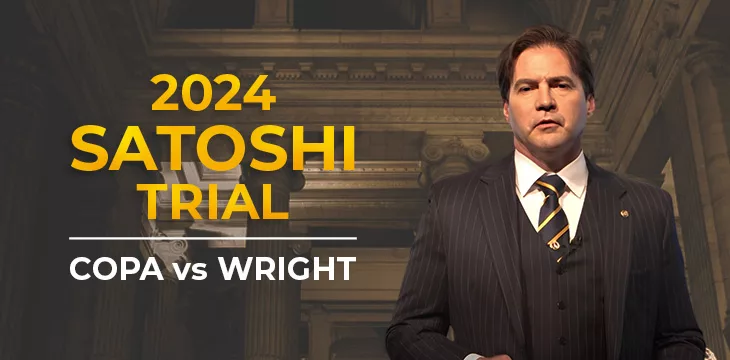By the time Dr. Craig Wright left the stand on his final day of examination in London’s Satoshi trial (COPA v Wright), Jonathan Hough KC, the barrister leading the charge for COPA (Crypto Open Patent Alliance), had Dr. Wright between his teeth for almost seven full days—ample time, in theory, to tear down the ‘brazen lies’ and ‘elaborate fiction’ that COPA has accused Dr. Wright of constructing to support his status as the inventor of Bitcoin.
Only it didn’t happen. Time and time again, Hough KC would put COPA’s allegations to him—fraud, perjury, document manipulation, plagiarism, intellectual property theft—and time and time again Dr. Wright had an answer.
When Hough KC tried to show that Microsoft’s ‘patch Tuesday’ doesn’t line up with a period of early downtime in Bitcoin (apparently rendering Dr. Wright’s account implausible), Dr. Wright explained that as a senior member of the Microsoft Developer Network he had pre-access to patches and was thus implementing them on his own, early schedule.
Or how about intense grilling on the legendary Tulip Trust and all its forms, where Hough KC painstakingly took Dr. Wright’s through much of his prior testimony on the Trust, looking for inconsistencies. A particular bugbear of Hough KC was apparent contradictions between Dr. Wright’s various accounts of whether the Tulip Trust holds Bitcoin. Dr. Wright had to point out, however, that Hough KC was continually confusing the Tulip Trust with ‘The Trust,’ which was the key sharing software Dr. Wright created in order to distribute and manage encryption keys owned by Trustees of the Tulip Trust proper: in light of that Hough KC’s supposed contradictions fell away completely.
More generally, Hough KC took any opportunity he could to trap Dr. Wright with his own words. By day five, Dr. Wright had been forced to make repeated references to his many qualifications, including the fact that he is presently undertaking five doctorate-level degrees. The last time Dr. Wright did this, Hough KC came back after lunch to try and seize an opportunity: he asked Dr. Wright to recount all the degrees. Of course, he did: a DBA on CBDCs at the Geneva Business School, a PhD in Law at the University of Leicester, a PhD in Mathematical Economics and Math at the University of Exeter, and two more DBAs at Walden University in Minnesota and Grand Canyon University in Arizona. Hough KC, as he had by then become so practised to do, moved on without comment.
By the end of the first week of trial, it had become clear that Hough KC and COPA were left with a fatal conundrum: what do you put to the man who knows everything?
That’s not to say that Hough KC’s questioning was anything other than diligent and direct. Indeed, he maintained a natural veneer of professionalism even as Dr. Wright’s answers left him floundering to draw on technical expertise he simply did not have. References to COPA’s expert reports which they say show Dr. Wright has forged documents on an ‘industrial scale’ became less effective day-by-day and hour-by-hour. It is telling that the expert reports had finally dropped out of Hough KC’s arsenal entirely by the second week of trial.
There were some glancing blows. Transcripts from Kleiman v Wright brought up by Hough KC showed Dr. Wright giving a very different account of Bitcoin’s invention, indicating that Satoshi Nakamoto could have been a trio which included a U.S. government official (it is worth mentioning that Kleiman was brought against Dr. Wright on Ira Kleiman’s pre-assumed notions of how Dr. Wright invented Bitcoin).
By and large, however, Dr. Craig Wright and his claim to the Satoshi Nakamoto name came out unscathed.
Dr. Wright’s ability to keep cool while under siege is only made more impressive by those brief lapses in demeanour so rarely exhibited by him on the stand. On the sixth day of questioning and with track clearly running out for Hough KC and COPA, the barrister began picking at the infamous 2016 ‘signing sessions’ and the circumstances of his outing by Wired and Gizmodo.
To anyone following along, this has always been a sore spot for Dr. Wright, as he recounted (again) in crushing detail in response to Hough KC’s questioning. At the time, Dr. Wright had no interest in being publicly identified as Satoshi and as he put it simply wanted to be left alone in an office so that he could invent. This is what led him to trust himself and his invention to Robert MacGregor, a Canadian businessman who Dr. Wright chose over a AUD$40 million deal with Australia’s Macquarie Bank—not on the understanding that Dr. Wright would publicly play the role of Satoshi that MacGregor so desperately wanted, but so that he could do the opposite.
MacGregor wouldn’t have it, and once Dr. Wright completed his move to London, MacGregor allegedly began pressuring Dr. Wright to participate in public signing sessions to show the world he was in possession of Satoshi’s private keys. At trial this week, COPA quibbled over whether Dr. Wright had signed an agreement handing the rights to his life story over to MacGregor, but whatever terms and conditions Dr. Wright might have unknowingly signed up to don’t matter: that Dr. Wright didn’t want to be known as Satoshi Nakamoto publicly is one of the most consistent details in all of Dr. Wright’s writings.
He also explained repeatedly throughout trial that this episode came just a few short years after Dr. Wright’s personal life was in turmoil (due in no small part to his invention of Bitcoin): he was getting divorced, he had ex-associates and employees trying to bankrupt him via the Australian courts, while the Australian Tax Office was waging its own campaign to destroy Dr. Wright and his companies.
Add to that a new batch of alleged threats from MacGregor and a ‘proof session’ involving signing with the Satoshi keys engineered behind Dr. Wright’s back, and there you have a perfect storm which culminated in a tragic suicide attempt by Dr. Wright (it did not culminate, however, in the Bitcoin experts present for the ‘proof session’ retracting their endorsement of Wright).
“Robert told me how he had [set up the signing sessions] and that if I didn’t do it, he would destroy me and my family. It was around the time that I hadn’t slept in 24 hours, and this is where I ended up having a suicide attempt. I thought I had been tricked into things and I was. I was forced into doing something I didn’t believe. I would have happily signed if – and only if – I could prove using all my life’s work and degrees, first.”
While being grilled over this period, Dr. Wright became noticeably more animated. His usual steady monotone erupting into passionate aggravation. Wright’s points were made no less effective by the high emotions.
Justice Mellor, as usual, gave nothing away, only asking a few probing questions at the conclusion of his testimony. We will have to wait some time to hear what the Judge thinks of all of this with weeks to go during trial and then a likely period of months before his judgment is ready to be issued. For now, however, it can be said that Dr. Wright’s claim has survived COPA’s best chance to make their case.
Check out all of the CoinGeek’s special reports on the Satoshi Trial (COPA v Wright).
New to blockchain? Check out CoinGeek’s Blockchain for Beginners section, the ultimate resource guide to learn more about blockchain technology.









